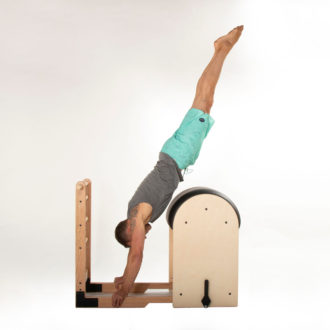Shapes in Space – Exploring a Straight Body Position
Pilates Stance, Leg Pull Front, Long Stretch, Balance Control Front, Cadillac Standing Arm Springs: Push Up, Press, Salute, or invert with Candlestick… there are so many exercises that begin with the body in a straight position!
Not to mention, straight body positions are found in exercises on every apparatus. For example, try Ladder Barrel’s Hand Stand for a real challenge. These straight body exercises create different challenges when placed in different relationships to gravity or on unstable surfaces, when used with smaller bases of support, or when acted upon by different outside forces, such as springs.
This is why it is so important to teach students how to perform a good standing Pilates Stance, as it reverberates throughout the entire work. Hone the nuances of Pilates Stance to help students progress this shape in space in all the different ways they will experience it in Pilates.
Pilates Stance is an activated, working posture where everything is pulled into the center and lifted up. The legs are pressed together with a natural turn out and the abs are engaged in an ‘in and up’ action. This is not ‘First Position’ from ballet, but rather it is expressed as a natural turn out of the hip or the position which you would experience if you hung from a bar and let your legs relax. This hip rotation is approximately 30 degrees for most people and Pilates Stance is used by military units all over the world because it is such an efficient stance.
So, try it in front of a mirror. Stand with your heels together and toes about four fingers apart. Your weight should be evenly distributed through the tripod of each foot, shared equally between the right and left feet. From this balanced base, pull upward into your Centerline, and squeeze your legs together as if saran wrap binds your thighs together, holding you in place.
The pelvis is in neutral with the gluteals lightly activated and the three anchors employed. The abs are pulled in and up to help to create axial elongation and to decompress the spine. Now, organize the rib cage so that it is even – your front and back working together to hold the torso in place (instead of standing with the back ribs collapsed downward and the front ribs protruding). Finally, widen your collarbones and lift your sternum to improve respiration and mood. Balance your head as through it was floating in the middle of the column.
Look in the mirror and notice if your nose is in line with your navel, and that your navel is in line with the center of your heels. You should be looking like a Greek Column! Notice if your eyes and ears are level. Often, we carry our heads incorrectly, tipping the chin upward and compressing the cervical vertebrae, so let the back of the head float up and back – feel the space and ease that’s created in this position.
Trouble Shooting:
Knock Knees/ Valgus Alignment: Reduce the width of the ‘V’, separate the heels as much as needed to accommodate the body. You want the thighs touching, but do not want the knees mashing together.
Bow Legs/ Varus Alignment: Open the ‘V’ wider. Pillow the empty space between the knees if needed.
Hip Flexor tightness: When the hip flexors are tight, it might be impossible for the student to come into a neutral pelvis position when standing or aligning in straight positions. Additionally, one’s ability to properly engage his or her gluteals will be impacted. So, start where the student is at in his/her body currently. Over time, Pilates will help him/her to improve overtime.
Pilates Stance Practice
Have some fun and take this shape into action! Stand tall and strong, then lift one leg up in the air, yes! Now you are doing the shape as it comes into play in Going up Front, or Pumping One -Leg Standing Front –two very functional exercises that translate into better stair or hill climbing.
So, next workout give some focus to this shape. Every time you move into it, work to bring better alignment into this shape and appreciate it from head to toe!
This article was contributed by Zoey Trap M.S., Executive Director of Education and Training at Peak Pilates®.



